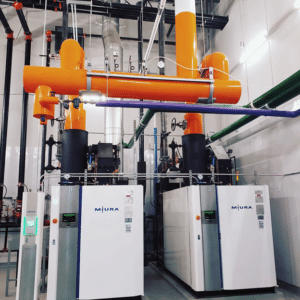How a Modular Steam Boiler System Works
For many years, large fire tube boilers have been the only game in town for businesses or organizations that needed to  produce large volumes of steam. However, advances in technology and design have created alternative options in the form of modular water tube steam boilers. A modular boiler system is distinct from traditional boilers but the results are similar, if not better. Let’s take a closer look at the modular steam boiler to better understand how it works and how it’s different from conventional boilers.
produce large volumes of steam. However, advances in technology and design have created alternative options in the form of modular water tube steam boilers. A modular boiler system is distinct from traditional boilers but the results are similar, if not better. Let’s take a closer look at the modular steam boiler to better understand how it works and how it’s different from conventional boilers.
Modular Boiler Design
The primary design difference between modular steam boilers and traditional boilers is size. Conventional boilers are massive, needing to be so big in order to meet the peak needs of a company or organization. Modular boilers, on the other hand, are much smaller and more compact. They were designed to address the often limited amount of space in a boiler room or steam plant. In addition to their compact size, modular boilers have no tube-pull space or door-swing space, further reducing their footprint and adding valuable space and flexibility.
Despite being smaller than conventional boilers, modular steam systems are still able to produce the same amount of steam, if not more steam, than older boilers. The low-volume pressure vessel makes it possible to achieve output capacities that are comparable to conventional boilers.
How Modular Boiler Size Matters
The key to modular steam boilers is that their smaller size makes it possible to install multiple boilers in the same space that was previously reserved for just one massive boiler. Although multiple boilers can be separate installations, it’s more common for them to share the same point-of-delivery, which is part of the purpose of replacing an old, conventional boiler with multiple modular boilers.
Having several modular boilers creates more flexibility to handle fluctuating needs and increase the overall efficiency of your boiler system. The smaller modular boilers are designed to work in tandem with one another. At the same time, they work independently of one another. For instance, each boiler has its own burner so that not every boiler in the system has to be lit simultaneously.
If the steam need is significant, all of the boilers can function at the same time, helping create the output of a larger boiler. However, when need drops, some can be shut off so that energy and fuel aren’t wasted. This gives a modular boiler system the flexibility to adapt to changing steam needs, while at the same time making it more energy-efficient.
With each boiler in the system having its own burner, it’s not only possible to shut down certain boilers when there’s a drop in need, but each boiler can also be shut down for maintenance without the entire system needing to be shut down. The smaller boiler size also makes inspections a lot faster, with the typical inspection lasting only a couple of hours. More importantly, steam production doesn’t have to drop significantly in the event one of the boilers requires maintenance or needs to be shut down for a routine inspection.
Modular Steam Boiler Control
A modular steam boiler system also makes it easy to alternate the boilers that are in use. A master controller can be used to vary the amount of steam being produced by each individual boiler so that the same one or two boilers aren’t doing all the heavy lifting while the rest only come on every now and then. This sequencing feature improves the efficiency of the entire system and reduces the wear and tear of each individual boiler, meaning that each boiler will last longer and require maintenance less frequently.
that the same one or two boilers aren’t doing all the heavy lifting while the rest only come on every now and then. This sequencing feature improves the efficiency of the entire system and reduces the wear and tear of each individual boiler, meaning that each boiler will last longer and require maintenance less frequently.
Unlike conventional boilers that take a long period of time to startup, which often requires them to be left in idle when steam needs are low, modular boilers are designed to be turned on and off quickly. Modular boilers can be started within a matter of minutes, so there’s no need to hesitate to turn one off when it’s not needed. The result of this is a significant reduction in the amount of water stored and the fuel used compared to conventional boilers.
The final design difference in modular steam boilers is how easy it can be to add or remove boilers when steam requirements change. The modular boilers take up less room than conventional boilers, and so there is typically room to expand without needing to expand the size of the boiler room or steam plant. A modular steam boiler system can significantly improve overall steam production compared to the outdated boilers of yesteryear.

